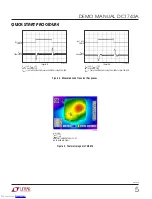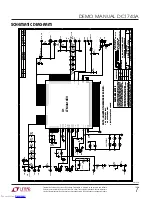
2
dc1743af
DEMO MANUAL DC1743A
qUick stArt proceDUre
Demonstration circuit DC1743A is an easy way to evalu-
ate the performance of the LTM4613EV. Please refer to
Figure 1 for proper measurement equipment setup and
follow the procedure below:
1. Place jumpers in the following positions for a typical
3.3V
OUT
application:
MODE
MARG1
MARG0
V
OUT
SELECT
RUN
CCM
LO
LO
3.3V
ON
2. With power off, connect the input power supply, load
and meters as shown in Figure 1. Preset the load to 0A
and V
IN
supply to be 0V.
3. Turn on the power at the input. Increase V
IN
to 12V
(do not hot-plug the input supply or apply more than
the rated maximum voltage of 36V to the board or the
part may be damaged). The output voltage should be
regulated and deliver the selected output voltage ± 2%.
4. Vary the input voltage from 5V to 36V and adjust the
load current from 0A to 8A. Observe the output voltage
regulation, ripple voltage, efficiency, and other param-
eters.
5. To measure input or output ripple, insert the scope
probe to J7 or J4.
6. For optional load transient test, apply an adjustable pulse
signal between IOSTEP_CLK and GND test points. The
pulse amplitude sets the load step current amplitude.
The pulse duty cycle should be low (< 5%) to limit the
thermal stress on the load transient circuit. The load
step current can be monitored with a BNC connected
to J3 (20mV/A). The output voltage can be monitored
at the probe jack J4.
Downloaded from
Downloaded from

























